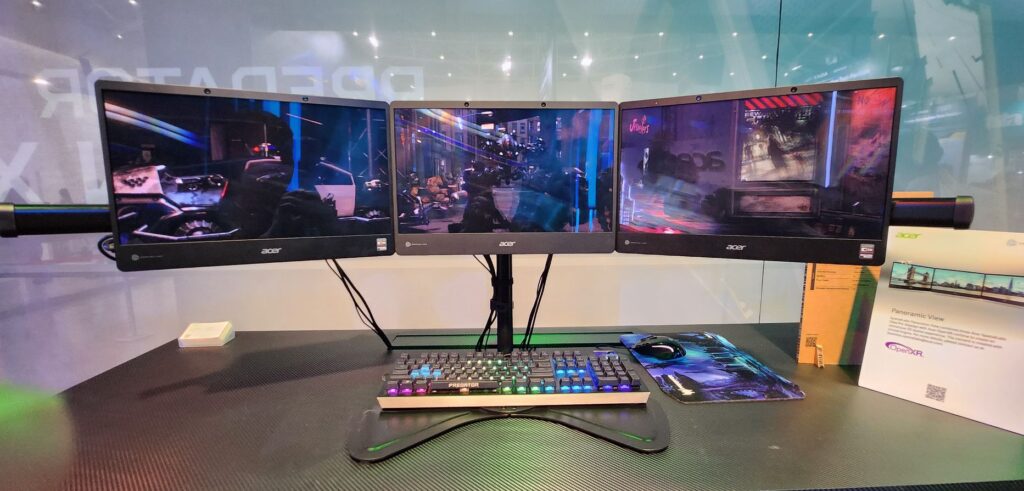
Exploring Acer’s SpatialLabs at Computex 2023: Are Glasses-Free 3D Displays Ready for Prime Time?
The concept of extended reality and its various attempts over the years, from virtual reality headsets to 3D displays, is not new. Development in the world of tech Many brands have ventured into this field, facing varying results due to technology limitations or cost.
At Computex 2023, Acer showcased their SpatialLabs stereoscopic display technologies in different deployments. Among the highlights was a massive triple display that offered a jaw-dropping example of three-dimensional imagery, alongside the Predator Helios 3D SpatialLabs Edition gaming laptop.

From left: Jane Hsu, Director, Business Development, Spatial Computing Product Business, Jerry Kao, Chief Operating Officer and President of IT Products Business, James K. Lin, General Manager, Notebook Products Business and Wayne Ma, General Manager IoB Business
Currently, SpatialLabs tech has limited deployment in selected Predator gaming laptop models and displays. The question arises: Is this technology ready for prime time compared to other extended reality technologies (XR) in the market? To shed more light on this, we had the opportunity to speak with Jane Hsu, Director of Business Development for Acer’s Spatial Computing Product Business.
SpatialLabs at Computex 2023: What was on show?
Acer has previously explored the creation of extended reality devices.. In 2016, they ventured into this field with the introduction of the StarVR headset. It featured ultra-wide displays integrated into a large and heavy headpiece, intended for vivid theme park attractions and virtual reality centres. However, interest dwindled over time. This time, Acer has introduced a new approach with their SpatialLabs stereoscopic displays.
Unlike clunky 3D glasses, Acer’s SpatialLabs stereoscopic displays utilise a pair of cameras to track left and right eye movement, creating a three-dimensional image on the display without the need for such glasses.

At the Acer Computex 2023 showcase, they demonstrated the SpatialLabs View Pro gaming display, which consisted of a 15.6-inch 4K panel capable of delivering a 3D image in 2K resolution per eye. When combined with two additional View Pro monitors to form a 120-degree angle of view, the 3D effect was truly impressive.
Another highlight was the Predator Helios 3D 15 Spatial Labs Edition gaming laptop. This powerhouse of a gaming laptop boasts a 13th Gen i9-13900HX processor, up to 32GB DDR5 RAM, an Nvidia GeForce RTX 4080 GPU, and up to a 2TB SSD in a Raid 0 configuration.

Its 15.6-inch IPS 4K display features a special 3D Stereoscopic module at the top, dividing the screen into two halves—one for each eye—to create a three-dimensional effect. The 3D effect is optional, reducing the default 4K resolution to 1,920 by 2,160 pixels in 3D mode. The result is an uncanny, yet vivid, experience with distinct objects in the foreground and background.
Is Acer SpatialLabs Ready for Prime Time?
While SpatialLabs 3D stereoscopic displays took centre stage and remain the focus of Acer’s current efforts, they are also exploring other extended reality technologies. Jane Hsu mentioned, “We are constantly exploring extended reality technologies. While we are pushing SpatialLabs 3D technologies, we are also looking into VR and AR. However, the overall user experience, in terms of technology and ergonomics, still has its limitations at present.”

The Acer Predator Helios 3D 15 Spatial Labs Edition features a pair of sterescopic cameras up top that tracks the left and right eye to create a 2K 3D image
She further added, “We’re waiting for the right convergence of technologies and are continuously working on new solutions in optics, rendering technologies, and lenses. Our goal is to bring these advancements to the general consumer sooner while ensuring a great experience. The timing is right for SpatialLabs 3D, and we have the technologies to deliver it to our customers.” Jane’s extensive experience in the field, including her previous work at StarVR labs, positions her well to lead Acer’s SpatialLabs arm and leverage their expertise in extended reality tech.
Jerry Kao Chief Operating Officer and President of IT Products Business and another pioneer of StarVR labs, emphasised their current focus on SpatialLabs 3D displays, citing the immaturity of VR technologies. As part of the team that developed the StarVR headset, Jerry acknowledged the challenges they faced, including user dizziness, as the cutting-edge technology was not fully matured at the time. Even now, he believes that VR technologies still have some way to go.
Regarding the possibility of licensing SpatialLabs technology, Jane explained that they have not yet explored that avenue as their primary focus is on delivering a superior user experience. However, she expressed openness to more brands entering the 3D technology market, as it would create a more cohesive ecosystem for customers.For more details on Acer’s SpatialLabs, you can visit their website at https://www.acer.com/my-en/spatiallabs.
